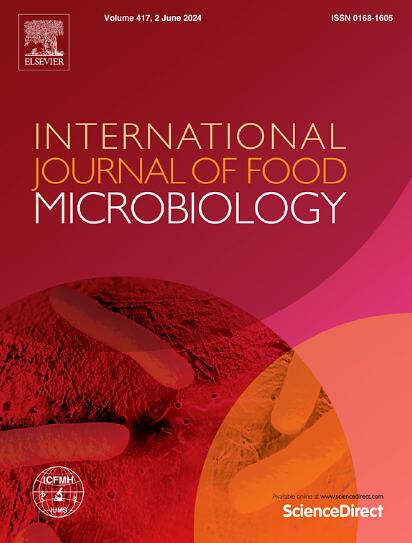Co-occurrence of qacEΔ1 disinfectant resistance gene and ARGs among Salmonella Indiana and its correlation with resistance to sodium hypochlorite
IF 5
1区 农林科学
Q1 FOOD SCIENCE & TECHNOLOGY
International journal of food microbiology
Pub Date : 2025-02-10
DOI:10.1016/j.ijfoodmicro.2025.111097
引用次数: 0
Abstract
Sodium hypochlorite (SHC) is the most commonly utilized carcass and equipment disinfectant in the poultry industry. However, prolonged exposure to SHC can result in the development of bacterial tolerance and exert co-selection on antimicrobial resistance. This study investigated the co-resistance to SHC and multiple antimicrobial agents among Salmonella enterica serovar Indiana (S. Indiana), with a specific focus on the co-occurrence of disinfectant resistance gene qacEΔ1 and the antimicrobial resistance genes (ARGs) revealed by whole genome sequencing (WGS). Additionally, the study examined the transcriptional response of qacEΔ1 and its closely associated ARGs under SHC pressure. Moreover, the study determined the optimal SHC concentration for the decontamination of multidrug-resistant (MDR) S. Indiana on chicken. The results indicated that S. Indiana exhibited a resistance rate of 73.31 % to SHC, and varying levels of resistance to 13 antimicrobial agents. Furthermore, the analysis revealed a significant correlation between the qacEΔ1 gene and ARGs, including catB3, sul1, arr-3 and blaOXA-1. The genetic contexts surrounding the qacEΔ1 gene demonstrated a high degree of homology, allowing for the categorization into 11 distinct genetic context types, among which the gene cluster aacA4-blaOXA-1-catB3-arr-3-qacEΔ1-sul1 was the most prevalent. Further analysis of the MDR IndS97 strain using PacBio SMRT sequencing revealed that the qacEΔ1 gene was located on plasmid pLKQY01, with IS26 and ISRle7 positioned at the flanks of the composite transposon aacA4-blaOXA-1-catB3-arr-3-qacEΔ1-sul1. The transcription levels of qacEΔ1, arr-3 and sul1 genes in response to SHC stress initially increased, followed by a decline as SHC concentrations rose. At an SHC concentration of 0.5 MIC, the transcription levels of these genes were notably low, and the results indicated a decontamination efficacy of 86.51 % against Salmonella contamination while relatively preserving the freshness of the chicken. This study enhanced the understanding of disinfectant effects on the antimicrobial resistance of S. Indiana and provided evidence to support the regulated use of disinfectants.
印第安纳沙门氏菌qacEΔ1消毒剂抗性基因与ARGs共现及其与次氯酸钠抗性的关系
次氯酸钠(SHC)是家禽业中最常用的胴体和设备消毒剂。然而,长时间暴露于SHC可导致细菌耐受性的发展,并对抗菌素耐药性进行共选择。本研究调查了印第安纳州肠沙门氏菌血清型(S. Indiana)对SHC和多种抗菌药物的共耐药情况,重点研究了消毒剂耐药基因qacEΔ1与抗菌药物耐药基因(ARGs)的共耐药情况。此外,本研究还检测了qacEΔ1及其密切相关的ARGs在SHC压力下的转录反应。此外,本研究还确定了多药耐药(MDR) S. Indiana对鸡的最佳SHC去污浓度。结果表明,印第安纳州葡萄球菌对SHC的耐药率为73.31%,对13种抗菌药物有不同程度的耐药率。此外,分析显示qacEΔ1基因与ARGs(包括catB3、sul1、arr-3和blaOXA-1)之间存在显著相关性。围绕qacEΔ1基因的遗传背景显示出高度的同源性,允许将其分类为11种不同的遗传背景类型,其中基因簇aacA4-blaOXA-1-catB3-arr-3-qacEΔ1-sul1最为普遍。通过PacBio SMRT测序进一步分析MDR IndS97菌株,发现qacEΔ1基因位于质粒pLKQY01上,IS26和ISRle7位于复合转座子aacA4-blaOXA-1-catB3-arr-3-qacEΔ1-sul1的两侧。在SHC胁迫下,qacEΔ1、arr-3和sul1基因的转录水平开始升高,随后随着SHC浓度的升高而下降。在SHC浓度为0.5 MIC时,这些基因的转录水平明显较低,结果表明对沙门氏菌污染的去除率为86.51%,同时相对保持了鸡肉的新鲜度。本研究加深了对消毒剂对印第安那州葡萄球菌耐药性影响的认识,为规范使用消毒剂提供了依据。
本文章由计算机程序翻译,如有差异,请以英文原文为准。
求助全文
约1分钟内获得全文
求助全文
来源期刊
CiteScore
10.40
自引率
5.60%
发文量
322
审稿时长
65 days
期刊介绍:
The International Journal of Food Microbiology publishes papers dealing with all aspects of food microbiology. Articles must present information that is novel, has high impact and interest, and is of high scientific quality. They should provide scientific or technological advancement in the specific field of interest of the journal and enhance its strong international reputation. Preliminary or confirmatory results as well as contributions not strictly related to food microbiology will not be considered for publication.

 求助内容:
求助内容: 应助结果提醒方式:
应助结果提醒方式:


